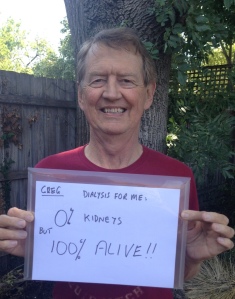I had an exciting email from MaryAnn & Rajiv in Bangalore, India earlier this month:
My name is MaryAnn George. I’m a kidney patient who recently underwent a transplant. My husband Rajiv Mathew & I are making an educational documentary video for End stage renal patients.
Title : Combat Kidney Disease
Language: English
Target audience: Patient / family / caregiver of ESRD patients
Purpose : Guide patients on how to deal with the disease & treatment options
Broad overview of contents: Understanding Kidney Disease, Medication & Diet, Living with dialysis, Preparing for transplant : Finding a donor / Documentation , Transplant surgery, Aftercare & life after transplant.
We have been through yourBigDandMe blog and feel that your experience will be able to provide some valuable information to other patients going through similar situations. It would be great if you could record a 10 min video (can even be shot on HD Phone camera) of yourself speaking about your experience. You can speak either about any topics mentioned below or as you have mentioned in your blog – how to stay healthy, actions to take to win your life back or what’s happening in the world of dialysis and transplant.
Suggested topics:
- How do you know when your kidney gets worse / symptoms?
- Choosing your dialysis center
- Dialysis experience
- Home dialysis & care
- Tips to prevent infection
- Post Dialysis fatigue
- Diet & exercise during dialysis phase
- Managing work and family & life style changes during dialysis phase
- Choosing your transplant doctor & hospital
- Documentation & Paper work – advice & tips
- Getting prepared – mentally/physically / financially
- Transplant surgery & ICU stay
- How long will recovery take? When can I drive/ Get back to work?
- Guidelines to follow after surgery
- Diet & lifestyle changes post-transplant
Please note, that this is a not for profit cause and aimed solely at helping other patients like ourselves. Kindly revert back if you are interested to be a part of this venture and I will share more details on the video specifications.
Thank you, MaryAnn & Rajiv, Bangalore, India
Great huh!
I think that a big part of the dialysis experience is the dread of starting. And the big surprise is how well most people feel once they are established and are dialysing well. So that’s what will be the subject of my video, and I would like to have as many BigD-ers involved as possible.
The first half of the video will be a few words about the worries, fears and dread of starting:
- The needles
- The big chunk of time I will lose every week for the rest of my life
- My lost freedom, being tied to regular visits to the machine
followed by a what the reality of dialysis is like for most of us.
Then, it will be over to you, my BigD friends (dialysers and carers):
Take a piece of blank, white US Letter or A4 paper. In landscape mode (with the widest part horizontal), using a thick, black felt-tip pen or marker, write your first name in the top lefthand corner, then in the center of the page: Dialysis to me:
Under that, 2 to 4 words that describe how you feel now about being on dialysis: angry, accepting, reluctant, enthusiastic, faulty or fortunate; tell it as you see it.
Then take a photo of you and your words, like this:
Don’t worry about making it a big production; as long as your message is readable.
Please send your photo to greg.collette(at)gmail.com by 16 January 2015.
I’m pretty sure that most of us, while we’re not euphoric about it, and would drop it if we could, still think dialysis is a pretty good deal: for a regular investment of our time, we get to live a reasonably healthy reasonably normal life.
No matter what we write, I think that this will be our message of hope to all those around the world lining up for the BigD the first time.
I’m excited and looking forward to seeing you and reading your messages! Greg

 Professional dialysis recruitment
Professional dialysis recruitment

